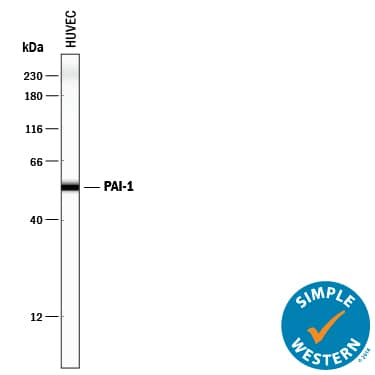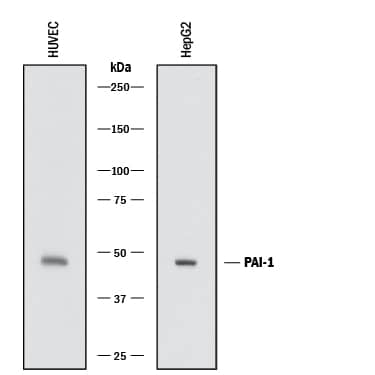Human Serpin E1/PAI-1 Antibody
R&D Systems, part of Bio-Techne | Catalog # MAB17861
Recombinant Monoclonal Antibody.

Key Product Details
Species Reactivity
Human
Applications
Simple Western, Western Blot
Label
Unconjugated
Antibody Source
Recombinant Monoclonal Rabbit IgG Clone # 1121C
Product Specifications
Immunogen
S. frugiperda insect ovarian cell line Sf 21-derived recombinant human Serpin E1/PAI‑1
Met1-Pro402
Accession # NP_000593
Met1-Pro402
Accession # NP_000593
Specificity
Detects human Serpin E1/PAI‑1 in direct ELISAs.
Clonality
Monoclonal
Host
Rabbit
Isotype
IgG
Scientific Data Images for Human Serpin E1/PAI-1 Antibody
Detection of Human Serpin E1/PAI-1 by Western Blot.
Western blot shows lysates of HUVEC human umbilical vein endothelial cells and HepG2 human hepatocellular carcinoma cell line. PVDF membrane was probed with 0.5 µg/mL of Rabbit Anti-Human Serpin E1/PAI-1 Monoclonal Antibody (Catalog # MAB17861) followed by HRP-conjugated Anti-Rabbit IgG Secondary Antibody (Catalog # HAF008). A specific band was detected for Serpin E1/PAI-1 at approximately 48 kDa (as indicated). This experiment was conducted under reducing conditions and using Immunoblot Buffer Group 1.Detection of Human Serpin E1/PAI‑1 by Simple WesternTM.
Simple Western lane view shows lysates of HUVEC human umbilical vein endothelial cells, loaded at 0.2 mg/mL. A specific band was detected for Serpin E1/PAI‑1 at approximately 55 kDa (as indicated) using 5 μg/mL of Rabbit Anti-Human Serpin E1/PAI‑1 Monoclonal Antibody (Catalog # MAB17861) . This experiment was conducted under reducing conditions and using the 12-230 kDa separation system. Non-specific interaction with the 230 kDa Simple Western standard may be seen with this antibody.Applications for Human Serpin E1/PAI-1 Antibody
Application
Recommended Usage
Simple Western
5 µg/mL
Sample: HUVEC human umbilical vein endothelial cells
Sample: HUVEC human umbilical vein endothelial cells
Western Blot
0.5 µg/mL
Sample: HUVEC human umbilical vein endothelial cells and HepG2 human hepatocellular carcinoma cell line
Sample: HUVEC human umbilical vein endothelial cells and HepG2 human hepatocellular carcinoma cell line
Reviewed Applications
Read 1 review rated 5 using MAB17861 in the following applications:
Formulation, Preparation, and Storage
Purification
Protein A or G purified from cell culture supernatant
Reconstitution
Reconstitute at 0.5 mg/mL in sterile PBS. For liquid material, refer to CoA for concentration.
Formulation
Lyophilized from a 0.2 μm filtered solution in PBS with Trehalose. *Small pack size (SP) is supplied either lyophilized or as a 0.2 µm filtered solution in PBS.
Shipping
Lyophilized product is shipped at ambient temperature. Liquid small pack size (-SP) is shipped with polar packs. Upon receipt, store immediately at the temperature recommended below.
Stability & Storage
Use a manual defrost freezer and avoid repeated freeze-thaw cycles.
- 12 months from date of receipt, -20 to -70 °C as supplied.
- 1 month, 2 to 8 °C under sterile conditions after reconstitution.
- 6 months, -20 to -70 °C under sterile conditions after reconstitution.
Background: Serpin E1/PAI-1
References
- Silverman, G.A. et al. (2001) J. Biol. Chem. 276:33293.
- Stefansson, S. et al. (2003) Curr. Pharm. Des. 9:1545.
- Duffy, M.J. (2002) Clin. Chem. 48:1194.
- Juhan-Vague, I. et al. (2003) J. Thromb. Haemost. 1:1575.
- Harbeck, N. et al. (2002) Clin. Breast Cancer 3:196.
- Pannekoek, H. et al. (1986) EMBO J. 5:2539.
- Ginsburg, D. et al. (1986) J. Clin. Invest. 78:1673.
- Wang, Z. et al. (1996) Biochemistry 35:16443.
- Stromqvist, M. et al. (1994) Protein Expr. Purif. 5:309.
Long Name
Plasminogen Activator Inhibitor
Alternate Names
Nexin, PAI-1, PAI1, PLANH1
Gene Symbol
SERPINE1
UniProt
Additional Serpin E1/PAI-1 Products
Product Documents for Human Serpin E1/PAI-1 Antibody
Product Specific Notices for Human Serpin E1/PAI-1 Antibody
For research use only
